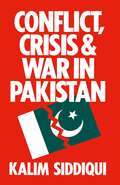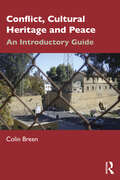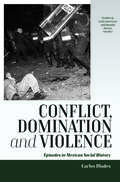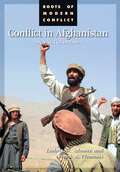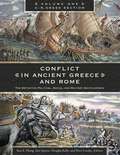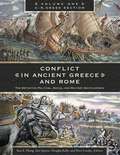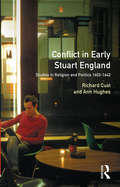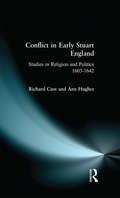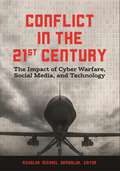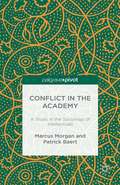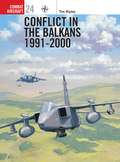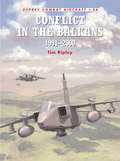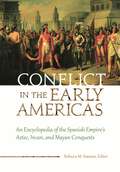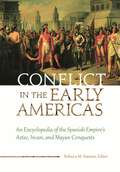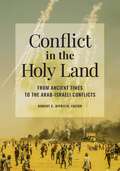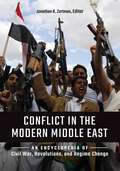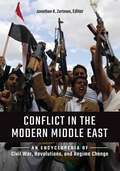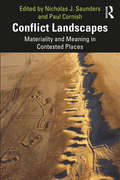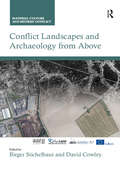- Table View
- List View
Conflict, Cultural Heritage and Peace: An Introductory Guide
by Colin BreenConflict, Cultural Heritage and Peace offers a series of conceptual and applied frameworks to help understand the role cultural heritage plays within conflict and the potential it has to contribute to positive peacebuilding and sustainable development in post-conflict societies. Designed as a resource guide, this general volume introduces the multiple roles cultural heritage plays through the conflict cycle from its onset, subsequent escalation and through to resolution and recovery. In its broadest sense, it questions what role cultural heritage plays within conflict, how cultural heritage is used in the construction and justification of conflict narratives, how are these narratives framed and often manipulated to support particular perspectives, and how we can develop better understandings of cultural heritage and work towards the better protection of cultural heritage resources during conflict. It moves beyond the protection paradigm and recognises that cultural heritage can contribute to building peace and reconciliation in post-conflict environments. The study offers a conceptual and operational framework to understand the roles cultural heritage plays within conflict cycles, how it can be targeted during war, and the potential cultural heritage has in positive peacebuilding across the conflict lifecycle. Conflict, Cultural Heritage, and Peace offers an invaluable introduction to cultural heritage at all stages in conflict scenarios which will benefit students, researchers and practitioners in the field of heritage, environment, peace and conflict studies.
Conflict, Cultural Heritage and Peace: An Introductory Guide
by Colin BreenConflict, Cultural Heritage and Peace offers a series of conceptual and applied frameworks to help understand the role cultural heritage plays within conflict and the potential it has to contribute to positive peacebuilding and sustainable development in post-conflict societies. Designed as a resource guide, this general volume introduces the multiple roles cultural heritage plays through the conflict cycle from its onset, subsequent escalation and through to resolution and recovery. In its broadest sense, it questions what role cultural heritage plays within conflict, how cultural heritage is used in the construction and justification of conflict narratives, how are these narratives framed and often manipulated to support particular perspectives, and how we can develop better understandings of cultural heritage and work towards the better protection of cultural heritage resources during conflict. It moves beyond the protection paradigm and recognises that cultural heritage can contribute to building peace and reconciliation in post-conflict environments. The study offers a conceptual and operational framework to understand the roles cultural heritage plays within conflict cycles, how it can be targeted during war, and the potential cultural heritage has in positive peacebuilding across the conflict lifecycle. Conflict, Cultural Heritage, and Peace offers an invaluable introduction to cultural heritage at all stages in conflict scenarios which will benefit students, researchers and practitioners in the field of heritage, environment, peace and conflict studies.
Conflict, Domination, and Violence: Episodes in Mexican Social History (Studies in Latin American and Spanish History #2)
by Carlos IlladesConflict, domination, violence—in this wide-ranging, briskly narrated volume from acclaimed Mexican historian Carlos Illades, these three phenomena register the pulse of a diverse, but inequitable and discriminatory, social order. Drawing on rich and varied historical sources, Illades guides the reader through seven signal episodes in Mexican social history, from rebellions under Porfirio Díaz’s dictatorship to the cycles of violence that have plagued the country’s deep south to the recent emergence of neo-anarchist movements. Taken together, they comprise a mosaic history of power and resistance, with artisans, rural communities, revolutionaries, students, and ordinary people confronting the forces of domination and transforming Mexican society.
Conflict in Afghanistan: An Encyclopedia (Roots of Modern Conflict)
by Frank A. Clements Ludwig W. AdamecA comprehensive A–Z study of the history of conflict in Afghanistan from 1747 to the present.This authoritative, clearly written volume covers all aspects of the conflicts that have taken place in Afghanistan from 1747 to the present. Conflict in Afghanistan provides the reader with a historical overview of hostilities in Afghanistan and discusses their causes, history, and impact on Afghan society and on regional and international relations.A single A–Z section covers the three main eras in Afghanistan's history: the period from 1747, when Afghanistan first emerged as a "unified" state; the Soviet era (1979–1989), which saw the overthrow of the monarchy, the declaration of the Republic, and the rise of the Mujahideen; and the post-Soviet period, which brought civil war, the rise of the Taliban, and finally the events of September 11 and the War on Terrorism, both of which receive special attention.
Conflict in Ancient Greece and Rome [3 volumes]: The Definitive Political, Social, and Military Encyclopedia [3 volumes]
by Iain Spence Douglas Kelly Peter Londey Sara E. PhangThe complex role warfare played in ancient Greek and Roman civilizations is examined through coverage of key wars and battles; important leaders, armies, organizations, and weapons; and other noteworthy aspects of conflict.Conflict in Ancient Greece and Rome: The Definitive Political, Social, and Military Encyclopedia is an outstandingly comprehensive reference work on its subject. Covering wars, battles, places, individuals, and themes, this thoroughly cross-referenced three-volume set provides essential support to any student or general reader investigating ancient Greek history and conflicts as well as the social and political institutions of the Roman Republic and Empire. The set covers ancient Greek history from archaic times to the Roman conquest and ancient Roman history from early Rome to the fall of the Western Roman Empire in 476 CE. It features a general foreword, prefaces to both sections on Greek history and Roman history, and maps and chronologies of events that precede each entry section. Each section contains alphabetically ordered articles—including ones addressing topics not traditionally considered part of military history, such as "noncombatants" and "war and gender"—followed by cross-references to related articles and suggested further reading. Also included are glossaries of Greek and Latin terms, topically organized bibliographies, and selected primary documents in translation.
Conflict in Ancient Greece and Rome [3 volumes]: The Definitive Political, Social, and Military Encyclopedia [3 volumes]
The complex role warfare played in ancient Greek and Roman civilizations is examined through coverage of key wars and battles; important leaders, armies, organizations, and weapons; and other noteworthy aspects of conflict.Conflict in Ancient Greece and Rome: The Definitive Political, Social, and Military Encyclopedia is an outstandingly comprehensive reference work on its subject. Covering wars, battles, places, individuals, and themes, this thoroughly cross-referenced three-volume set provides essential support to any student or general reader investigating ancient Greek history and conflicts as well as the social and political institutions of the Roman Republic and Empire. The set covers ancient Greek history from archaic times to the Roman conquest and ancient Roman history from early Rome to the fall of the Western Roman Empire in 476 CE. It features a general foreword, prefaces to both sections on Greek history and Roman history, and maps and chronologies of events that precede each entry section. Each section contains alphabetically ordered articles—including ones addressing topics not traditionally considered part of military history, such as "noncombatants" and "war and gender"—followed by cross-references to related articles and suggested further reading. Also included are glossaries of Greek and Latin terms, topically organized bibliographies, and selected primary documents in translation.
Conflict In Early Stuart England: Studies In Religion And Politics 1603-1642 (PDF)
by Richard Cust Ann HughesThis important collection of essays, based on extensive original research, presents a vigorous critique of 'revisionist' analyses of the period, and reasserts the importance of long term ideological and social developments in causing the outbreak of the civil war.
Conflict in Early Stuart England: Studies in Religion and Politics 1603-1642
by Richard Cust Ann HughesThis important collection of essays, based on extensive original research, presents a vigorous critique of ` revisionist' analyses of the period, and reasserts the importance of long term ideological and social developments in causing the outbreak of the civil war.
Conflict in Early Stuart England: Studies in Religion and Politics 1603-1642
by Richard Cust Ann HughesThis important collection of essays, based on extensive original research, presents a vigorous critique of ` revisionist' analyses of the period, and reasserts the importance of long term ideological and social developments in causing the outbreak of the civil war.
Conflict in the 21st Century: The Impact of Cyber Warfare, Social Media, and Technology
by Nicholas Michael SambalukThis reference work examines how sophisticated cyber-attacks and innovative use of social media have changed conflict in the digital realm, while new military technologies such as drones and robotic weaponry continue to have an impact on modern warfare.Cyber warfare, social media, and the latest military weapons are transforming the character of modern conflicts. This book explains how, through overview essays written by an award-winning author of military history and technology topics; in addition to more than 200 entries dealing with specific examples of digital and physical technologies, categorized by their relationship to cyber warfare, social media, and physical technology areas. Individually, these technologies are having a profound impact on modern conflicts; cumulatively, they are dynamically transforming the character of conflicts in the modern world.The book begins with a comprehensive overview essay on cyber warfare and a large section of A–Z reference entries related to this topic. The same detailed coverage is given to both social media and technology as they relate to conflict in the 21st century. Each of the three sections also includes an expansive bibliography that serves as a gateway for further research on these topics. The book ends with a detailed chronology that helps readers place all the key events in these areas.
Conflict in the 21st Century: The Impact of Cyber Warfare, Social Media, and Technology
by Nicholas Michael SambalukThis reference work examines how sophisticated cyber-attacks and innovative use of social media have changed conflict in the digital realm, while new military technologies such as drones and robotic weaponry continue to have an impact on modern warfare.Cyber warfare, social media, and the latest military weapons are transforming the character of modern conflicts. This book explains how, through overview essays written by an award-winning author of military history and technology topics; in addition to more than 200 entries dealing with specific examples of digital and physical technologies, categorized by their relationship to cyber warfare, social media, and physical technology areas. Individually, these technologies are having a profound impact on modern conflicts; cumulatively, they are dynamically transforming the character of conflicts in the modern world.The book begins with a comprehensive overview essay on cyber warfare and a large section of A–Z reference entries related to this topic. The same detailed coverage is given to both social media and technology as they relate to conflict in the 21st century. Each of the three sections also includes an expansive bibliography that serves as a gateway for further research on these topics. The book ends with a detailed chronology that helps readers place all the key events in these areas.
Conflict in the Academy: A Study in the Sociology of Intellectuals
by M. Morgan P. BaertExamining an intramural conflict that erupted within the English Faculty at Cambridge University in the early 1980s, this book develops a theoretical analysis of disputes as they unfold within the academy and explores the broader historical shifts within Higher Education and how these related to developments in Continental Europe.
Conflict in the Balkans 1991–2000 (Combat Aircraft)
by Mark Rolfe Tim RipleyExposing the true scale and significance of the deployment of air power in the Balkans, this book details the activities of NATO and UN aircraft as well as local pilots in the former Yugoslavia. From bombing by B-2 stealth bombers to air-to-air combat; from moving ground troops by helicopter to 'food-bombing' for refugees, air power has played a vital role in 'Europe's Vietnam', and there is little sign that the fires of conflict are being extinguished. Debate amongst air power practitioners has yielded little agreement as to the degree of damage inflicted on the Yugoslav 3rd Army in Kosovo, the Balkans continue to be a region of conflict and ethnic hatred.
Conflict in the Balkans 1991–2000 (Combat Aircraft #24)
by Mark Rolfe Tim RipleyExposing the true scale and significance of the deployment of air power in the Balkans, this book details the activities of NATO and UN aircraft as well as local pilots in the former Yugoslavia. From bombing by B-2 stealth bombers to air-to-air combat; from moving ground troops by helicopter to 'food-bombing' for refugees, air power has played a vital role in 'Europe's Vietnam', and there is little sign that the fires of conflict are being extinguished. Debate amongst air power practitioners has yielded little agreement as to the degree of damage inflicted on the Yugoslav 3rd Army in Kosovo, the Balkans continue to be a region of conflict and ethnic hatred.
Conflict in the Early Americas: An Encyclopedia of the Spanish Empire's Aztec, Incan, and Mayan Conquests
by Rebecca M. SeamanThis detailed study is the only reference work of its kind to address Spain's conquest of Central and South America, providing in-depth coverage of native and European ideologies, political motivations, and cultural practices of the region.As the study of world history evolves from a Eurocentric perspective to a more global viewpoint, formerly marginalized groups are now the focus of discussion, revealing a background rich with important military, political, social, and economic achievements. This book examines the once prosperous and powerful native civilizations in Central and South America, discussing the key individuals, strategies, and politics that made these countries strong and indomitable. In spite of this, the author shows how, in only a few generations, Spain defeated these mini-empires, eventually dominating much of the Western Hemisphere.Conflict in the Early Americas: An Encyclopedia of the Spanish Empire's Aztec, Incan, and Mayan Conquests focuses primarily on the defeat of the Aztec, Incan, and Mayan civilizations, but also includes Spanish interactions with lesser-known native groups. Supporting documents including primary sources, maps, and visual aids provide necessary context to this once-untold story.
Conflict in the Early Americas: An Encyclopedia of the Spanish Empire's Aztec, Incan, and Mayan Conquests
by Rebecca M. SeamanThis detailed study is the only reference work of its kind to address Spain's conquest of Central and South America, providing in-depth coverage of native and European ideologies, political motivations, and cultural practices of the region.As the study of world history evolves from a Eurocentric perspective to a more global viewpoint, formerly marginalized groups are now the focus of discussion, revealing a background rich with important military, political, social, and economic achievements. This book examines the once prosperous and powerful native civilizations in Central and South America, discussing the key individuals, strategies, and politics that made these countries strong and indomitable. In spite of this, the author shows how, in only a few generations, Spain defeated these mini-empires, eventually dominating much of the Western Hemisphere.Conflict in the Early Americas: An Encyclopedia of the Spanish Empire's Aztec, Incan, and Mayan Conquests focuses primarily on the defeat of the Aztec, Incan, and Mayan civilizations, but also includes Spanish interactions with lesser-known native groups. Supporting documents including primary sources, maps, and visual aids provide necessary context to this once-untold story.
Conflict in the Holy Land: From Ancient Times to the Arab-Israeli Conflicts
by Robert C. DiPrizioWith more than 250 cross-referenced entries covering every aspect of conflict in the Holy Land, this illuminating book will help students understand the volatile history of Palestine and Israel and its impact on the rest of the world.Palestine is considered a sacred land by Christians, Jews, and Muslims. This has contributed to the violence that has ravaged the Holy Land throughout its long history. This A–Z reference work, which defines the Holy Land as historic Palestine (the combined territories of Israel, the West Bank, and the Gaza Strip), covers such ancient conflicts as Egypt's rule over Canaan, the reign of King David, and the Jewish Revolts against the Roman Empire. In addition, the title includes detailed entries on such medieval conflicts as the Crusades and such contemporary conflicts as the Arab-Israeli wars.The reference begins with an introduction that provides readers with the necessary context to understand the region's bloody history and a comprehensive chronology that will help students construct a more complete picture of conflict in the Holy Land. Then come hundreds of key entries on the events, individuals, groups, places, and ideologies that have played an important role in the strife there. The title concludes with an expansive bibliography that will aid students looking to do more research on the topic and a thorough index.
Conflict in the Holy Land: From Ancient Times to the Arab-Israeli Conflicts
by Robert C. DiPrizio, EditorWith more than 250 cross-referenced entries covering every aspect of conflict in the Holy Land, this illuminating book will help students understand the volatile history of Palestine and Israel and its impact on the rest of the world.Palestine is considered a sacred land by Christians, Jews, and Muslims. This has contributed to the violence that has ravaged the Holy Land throughout its long history. This A–Z reference work, which defines the Holy Land as historic Palestine (the combined territories of Israel, the West Bank, and the Gaza Strip), covers such ancient conflicts as Egypt's rule over Canaan, the reign of King David, and the Jewish Revolts against the Roman Empire. In addition, the title includes detailed entries on such medieval conflicts as the Crusades and such contemporary conflicts as the Arab-Israeli wars.The reference begins with an introduction that provides readers with the necessary context to understand the region's bloody history and a comprehensive chronology that will help students construct a more complete picture of conflict in the Holy Land. Then come hundreds of key entries on the events, individuals, groups, places, and ideologies that have played an important role in the strife there. The title concludes with an expansive bibliography that will aid students looking to do more research on the topic and a thorough index.
Conflict in the Modern Middle East: An Encyclopedia of Civil War, Revolutions, and Regime Change
by Jonathan K. Zartman, EditorThis book provides detailed coverage of all the key conflict-related developments since the Arab Spring, a seminal event that began in December 2010 and continues to have major influence on events in the Middle East, North Africa, and beyond.This important reference offers readers a thorough understanding of the nature of the various conflicts that have erupted in the Middle East and North Africa following the Arab Spring. Clear and concise explanations of important concepts related to Islam, ideology, and ethnicity and the economic, social, and cultural forces propelling conflict and revolution in the region will enable readers to gain insight into key developments there. Biographical and organizational profiles combined with succinct overviews of each country provide a strong research foundation for students.The book offers detailed descriptions of the minority groups that have suffered violence from both the countries and the societies around them, sometimes generating refugee flows that engage neighboring states in security issues. It also discusses the role of women in the region during these turbulent times. Primary source documents and a chronology highlight political struggles to reach durable agreements and develop institutions to meet basic human needs in the modern Middle East.
Conflict in the Modern Middle East: An Encyclopedia of Civil War, Revolutions, and Regime Change
by Jonathan K. ZartmanThis book provides detailed coverage of all the key conflict-related developments since the Arab Spring, a seminal event that began in December 2010 and continues to have major influence on events in the Middle East, North Africa, and beyond.This important reference offers readers a thorough understanding of the nature of the various conflicts that have erupted in the Middle East and North Africa following the Arab Spring. Clear and concise explanations of important concepts related to Islam, ideology, and ethnicity and the economic, social, and cultural forces propelling conflict and revolution in the region will enable readers to gain insight into key developments there. Biographical and organizational profiles combined with succinct overviews of each country provide a strong research foundation for students.The book offers detailed descriptions of the minority groups that have suffered violence from both the countries and the societies around them, sometimes generating refugee flows that engage neighboring states in security issues. It also discusses the role of women in the region during these turbulent times. Primary source documents and a chronology highlight political struggles to reach durable agreements and develop institutions to meet basic human needs in the modern Middle East.
Conflict Landscapes: Materiality and Meaning in Contested Places
by Nicholas J. Saunders and Paul CornishConflict Landscapes explores the long under-acknowledged and under-investigated aspects of where and how modern conflict landscapes interact and conjoin with pre-twentieth-century places, activities, and beliefs, as well as with individuals and groups. Investigating and understanding the often unpredictable power and legacies of landscapes that have seen (and often still viscerally embody) the consequences of mass death and destruction, the book shows, through these landscapes, the power of destruction to preserve, refocus, and often reconfigure the past. Responding to the complexity of modern conflict, the book offers a coherent, integrated, and sensitized hybrid approach, which calls on different disciplines where they overlap in a shared common terrain. Dealing with issues such as memory, identity, emotion, and wellbeing, the chapters tease out the human experience of modern conflict and its relationship to landscape. Conflict Landscapes will appeal to a wide range of disciplines involved in studying conflict, such as archaeology, anthropology, material culture studies, art history, cultural history, cultural geography, military history, and heritage and museum studies.
Conflict Landscapes: Materiality and Meaning in Contested Places
by Nicholas J. Saunders Paul CornishConflict Landscapes explores the long under-acknowledged and under-investigated aspects of where and how modern conflict landscapes interact and conjoin with pre-twentieth-century places, activities, and beliefs, as well as with individuals and groups. Investigating and understanding the often unpredictable power and legacies of landscapes that have seen (and often still viscerally embody) the consequences of mass death and destruction, the book shows, through these landscapes, the power of destruction to preserve, refocus, and often reconfigure the past. Responding to the complexity of modern conflict, the book offers a coherent, integrated, and sensitized hybrid approach, which calls on different disciplines where they overlap in a shared common terrain. Dealing with issues such as memory, identity, emotion, and wellbeing, the chapters tease out the human experience of modern conflict and its relationship to landscape. Conflict Landscapes will appeal to a wide range of disciplines involved in studying conflict, such as archaeology, anthropology, material culture studies, art history, cultural history, cultural geography, military history, and heritage and museum studies.
Conflict Landscapes and Archaeology from Above (Material Culture and Modern Conflict)
by Birger Stichelbaut David CowleyThe study of conflict archaeology has developed rapidly over the last decade, fuelled in equal measure by technological advances and creative analytical frameworks. Nowhere is this truer than in the inter-disciplinary fields of archaeological practice that combine traditional sources such as historical photographs and maps with 3D digital topographic data from Airborne Laser Scanning (ALS) and large scale geophysical prospection. For twentieth-century conflict landscapes and their surviving archaeological remains, these developments have encouraged a shift from a site oriented approach towards landscape-scaled research. This volume brings together an wide range of perspectives, setting traditional approaches that draw on historical and contemporary aerial photographs alongside cutting-edge prospection techniques, cross-disciplinary analyses and innovative methods of presenting this material to audiences. Essays from a range of disciplines (archaeology, history, geography, heritage and museum studies) studying conflict landscapes across the globe throughout the twentieth century, all draw on aerial and landscape perspectives to past conflicts and their legacy and the complex issues for heritage management. Organized in four parts, the first three sections take a broadly chronological approach, exploring the use of aerial evidence to expand our understanding of the two World Wars and the Cold War. The final section explores ways that the aerial perspective can be utilized to represent historical landscapes to a wide audience. With case studies ranging from the Western Front to the Cold War, Ireland to Russia, this volume demonstrates how an aerial perspective can both support and challenge traditional archaeological and historical analysis, providing an innovative new means of engaging with the material culture of conflict and commemoration.
Conflict Landscapes and Archaeology from Above (Material Culture and Modern Conflict)
by Birger Stichelbaut David CowleyThe study of conflict archaeology has developed rapidly over the last decade, fuelled in equal measure by technological advances and creative analytical frameworks. Nowhere is this truer than in the inter-disciplinary fields of archaeological practice that combine traditional sources such as historical photographs and maps with 3D digital topographic data from Airborne Laser Scanning (ALS) and large scale geophysical prospection. For twentieth-century conflict landscapes and their surviving archaeological remains, these developments have encouraged a shift from a site oriented approach towards landscape-scaled research. This volume brings together an wide range of perspectives, setting traditional approaches that draw on historical and contemporary aerial photographs alongside cutting-edge prospection techniques, cross-disciplinary analyses and innovative methods of presenting this material to audiences. Essays from a range of disciplines (archaeology, history, geography, heritage and museum studies) studying conflict landscapes across the globe throughout the twentieth century, all draw on aerial and landscape perspectives to past conflicts and their legacy and the complex issues for heritage management. Organized in four parts, the first three sections take a broadly chronological approach, exploring the use of aerial evidence to expand our understanding of the two World Wars and the Cold War. The final section explores ways that the aerial perspective can be utilized to represent historical landscapes to a wide audience. With case studies ranging from the Western Front to the Cold War, Ireland to Russia, this volume demonstrates how an aerial perspective can both support and challenge traditional archaeological and historical analysis, providing an innovative new means of engaging with the material culture of conflict and commemoration.
